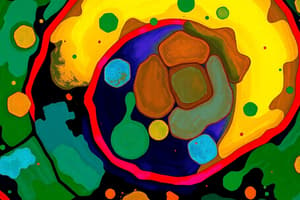Podcast
Questions and Answers
Which structure in plant cells is primarily responsible for maintaining turgor pressure?
Which structure in plant cells is primarily responsible for maintaining turgor pressure?
- Cell Wall
- Chloroplasts
- Vacuole (correct)
- Nucleus
What is the main function of chloroplasts in plant cells?
What is the main function of chloroplasts in plant cells?
- Photosynthesis (correct)
- Protein synthesis
- Storage of nutrients
- Cellular respiration
Which of the following cell types is involved in flexible support in young plant structures?
Which of the following cell types is involved in flexible support in young plant structures?
- Collenchyma (correct)
- Sclerenchyma
- Xylem
- Parenchyma
Which organelle is known as the powerhouse of the cell, converting food into energy?
Which organelle is known as the powerhouse of the cell, converting food into energy?
What distinguishes plant cells from animal cells?
What distinguishes plant cells from animal cells?
What role does the endoplasmic reticulum play in plant cells?
What role does the endoplasmic reticulum play in plant cells?
Which plant cell type is primarily responsible for transporting sugars throughout the plant?
Which plant cell type is primarily responsible for transporting sugars throughout the plant?
What does the Golgi apparatus do in plant cells?
What does the Golgi apparatus do in plant cells?
Flashcards are hidden until you start studying
Study Notes
Key Features of Plant Cells
-
Cell Wall:
- Rigid outer layer made of cellulose.
- Provides structure and protection.
-
Cell Membrane:
- Semi-permeable layer that regulates entry and exit of substances.
-
Chloroplasts:
- Organelles that contain chlorophyll.
- Sites of photosynthesis, converting sunlight into energy.
-
Vacuole:
- Large central vacuole filled with cell sap.
- Maintains turgor pressure, stores nutrients, and waste products.
-
Cytoplasm:
- Gel-like substance where organelles are suspended.
- Site of metabolic processes.
-
Nucleus:
- Contains genetic material (DNA).
- Controls cell activities and regulates gene expression.
-
Endoplasmic Reticulum (ER):
- Rough ER: Studded with ribosomes; synthesizes proteins.
- Smooth ER: Lacks ribosomes; synthesizes lipids and detoxifies.
-
Golgi Apparatus:
- Modifies, sorts, and packages proteins and lipids for secretion or delivery to other organelles.
-
Mitochondria:
- Powerhouse of the cell; site of cellular respiration.
- Converts food into ATP (energy).
-
Ribosomes:
- Sites of protein synthesis; can be free-floating or attached to the ER.
Distinctions from Animal Cells
- Presence of a cell wall, chloroplasts, and a large central vacuole.
- Lack of centrioles and lysosomes (commonly found in animal cells).
Functions of Plant Cells
-
Photosynthesis:
- Conversion of light energy into chemical energy using chloroplasts.
-
Storage:
- Storing starch, proteins, and other nutrients in vacuoles.
-
Support and Structure:
- Cell walls provide rigidity and support to plant structures.
-
Transport:
- Xylem and phloem cells assist in the transport of water, nutrients, and food throughout the plant.
Types of Plant Cells
-
Parenchyma:
- Most common type; involved in storage, photosynthesis, and tissue repair.
-
Collenchyma:
- Provides flexible support in young plant stems and leaves.
-
Sclerenchyma:
- Provides rigid support; cells are often dead at maturity.
-
Xylem:
- Transports water and dissolved minerals from roots to leaves.
-
Phloem:
- Transports sugars and other organic compounds throughout the plant.
Summary
Plant cells are specialized for functions like photosynthesis, storage, and support, distinguished by their unique structures, including a cell wall and chloroplasts. Understanding these components and their functions is crucial for studying plant biology and physiology.
Key Features of Plant Cells
- Cell Wall:
- Composed of cellulose, providing structural support and protection to the cell.
- Cell Membrane:
- Semi-permeable barrier controlling the movement of substances in and out of the cell.
- Chloroplasts:
- Contain chlorophyll for photosynthesis, transforming sunlight into chemical energy.
- Vacuole:
- Large central vacuole filled with cell sap; maintains turgor pressure, and stores nutrients and waste.
- Cytoplasm:
- Gel-like medium where organelles reside; site of various metabolic processes.
- Nucleus:
- Houses genetic material (DNA); regulates cell activities and gene expression.
- Endoplasmic Reticulum (ER):
- Rough ER synthesizes proteins due to ribosomes; Smooth ER synthesizes lipids and detoxifies harmful substances.
- Golgi Apparatus:
- Responsible for modifying, sorting, and packaging proteins and lipids for export or delivery to organelles.
- Mitochondria:
- Powerhouse of the cell; processes cellular respiration to convert nutrients into ATP, the cell's energy currency.
- Ribosomes:
- Sites of protein synthesis, can be found free-floating in the cytoplasm or attached to the ER.
Distinctions from Animal Cells
- Unique presence of the cell wall, chloroplasts for photosynthesis, and large central vacuole in plant cells.
- Absence of centrioles and lysosomes, commonly found in animal cells.
Functions of Plant Cells
- Photosynthesis:
- Utilizes chloroplasts to convert light energy into chemical energy stored in glucose.
- Storage:
- Vacuoles store substances like starch and proteins, essential for cell metabolism and growth.
- Support and Structure:
- Rigid cell walls provide essential support to maintain the plant's shape and structure.
- Transport:
- Specialized xylem and phloem cells transport water, nutrients, and sugars throughout the plant.
Types of Plant Cells
- Parenchyma:
- Most prevalent cell type; involved in storage, photosynthesis, and healing processes.
- Collenchyma:
- Offers flexible support, particularly in young stems and leaves.
- Sclerenchyma:
- Provides rigid structural support; cells typically die at maturity.
- Xylem:
- Conducts water and dissolved minerals from the roots to aerial parts of the plant.
- Phloem:
- Distributes sugars and organic compounds produced through photosynthesis across the plant.
Summary
Plant cells are uniquely structured to perform essential functions like photosynthesis, nutrient storage, and structural support, characterized by cellular components such as the cell wall and chloroplasts. Understanding these elements is crucial for comprehending plant biology and physiology.
Studying That Suits You
Use AI to generate personalized quizzes and flashcards to suit your learning preferences.





